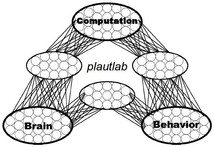Dr. David C. Plaut
I'm a Professor of Psychology at Carnegie Mellon University with a secondary appointment in the Carnegie Mellon Neuroscience Institute. My research involves using computational modeling, complemented by empirical studies, to investigate the nature of normal and disordered cognitive processing in the domains of high-level vision, reading and language, and semantics. My modeling work is cast within a connectionist or neural network framework, in which cognitive processes are implemented in terms of cooperative and competitive interactions among large numbers of simple, neuron-like processing units. These models can provide insight into how cognitive processes are implemented in the brain, and how disorders of brain function lead to disorders of cognition. I'm particularly interested in studying the effects of damage in connectionist networks as a way of understanding the nature of cognitive impairments that can arise following brain damage, and in exploring ways of retraining damaged networks to inform patient rehabilitation. I'm also interested in the implications of connectionist learning principles for the nature of typical and atypical cognitive development.
I don't anticipate taking on new graduate students for the foreseeable future.
Representative Publications
- Blauch, N.M., Plaut, D.C., Vin, R., and Behrmann, M. (2025). Individual variation in the functional lateralization of human ventral temporal cortex: Local competition and long-range coupling. Imaging Neuroscience, 3, 1-33. (link)
- Blauch, N.M., Behrmann, M., and Plaut, D.C. (2022). A connectivity-constrained computational account of topographic organization in primate high-level visual cortex. Proceedings of the National Academy of Science USA, 19(3), e2112566119. (link)
- Cheyette, S.J. and Plaut, D.C. (2017). Modeling the N400 ERP component as transient semantic over-activation within a neural network model of word comprehension. Cognition, 162, 153-166. (link)
- Plaut, D.C., and Vande Velde, A.K. (2017). Statistical learning of parts and wholes: A neural network approach. Journal of Experimental Psychology: General, 146, 318-336. (link)
- Plaut, D.C., and Behrmann, M. (2011). Complementary neural representations for faces and words: A computational exploration. Cognitive Neuropsychology, 28, 251-275. (link)
- Botvinick, M., and Plaut, D.C. (2006). Short-term memory for serial order: A recurrent neural network model. Psychological Review, 113, 201-233. (link)
- Botvinick, M., and Plaut, D.C. (2004). Doing without schema hierarchies: A recurrent connectionist approach to normal and impaired routine sequential action. Psychological Review, 111, 395-429. (link)
- Plaut, D.C., and Booth, J. R. (2000). Individual and developmental differences in semantic priming: Empirical and computational support for a single-mechanism account of lexical processing. Psychological Review, 107, 786-823. (link)
- Plaut, D.C., McClelland, J. L., Seidenberg, M. S., and Patterson, K. (1996). Understanding normal and impaired word reading: Computational principles in quasi-regular domains. Psychological Review, 103, 56-115. (link)
- Plaut, D.C., and Shallice, T. (1993). Deep dyslexia: A case study of connectionist neuropsychology. Cognitive Neuropsychology, 10, 377-500. (link)


